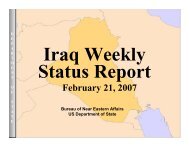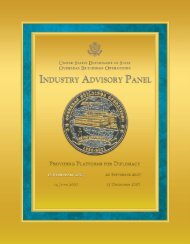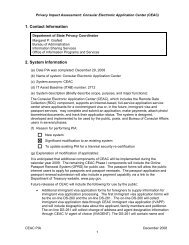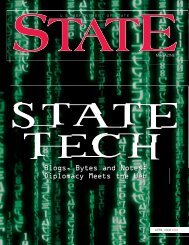Paper - Association of American Geographers
Paper - Association of American Geographers
Paper - Association of American Geographers
You also want an ePaper? Increase the reach of your titles
YUMPU automatically turns print PDFs into web optimized ePapers that Google loves.
who pretend to <strong>of</strong>fer services in the area <strong>of</strong> GIS. There exists the Botswana Surveying and<br />
Mapping <strong>Association</strong> whose focus seems to be on the surveying and mapping fraternity alone.<br />
In respect <strong>of</strong> coordination it is expected that institution arrangements need to be strengthened and<br />
that the current ad-hoc arrangements <strong>of</strong> working groups who do it on volunteer basis cannot be<br />
sustainable.<br />
Technology<br />
No doubt technology forms the backbone <strong>of</strong> all the activities in the SDI. The acquisition and<br />
maintenance <strong>of</strong> such technology is normally the mandate <strong>of</strong> the Department <strong>of</strong> Information and<br />
Technology within the government. Proposals for hardware and s<strong>of</strong>tware acquisition to enable<br />
effective e-government have been received well within government. It has been suggested that<br />
enterprise licencing arrangements be entered into between government and service providers so<br />
as to allow for economies <strong>of</strong> scale.<br />
People<br />
The greatest challenge in the successful implementation <strong>of</strong> any technology seems to be people.<br />
While new solutions are being proposed there sometimes is lesser investment in the people who<br />
should run those systems. One observes that most <strong>of</strong> the systems that have been or are in the<br />
process <strong>of</strong> being implemented are based on a champion in the organization. In the event that the<br />
champion leaves that organization there is little doubt that the system would face major<br />
challenges and sometimes could become redundant.<br />
In the organization <strong>of</strong> coordination one observes that little has been done to set up a proper<br />
coordinating unit with capable personnel to run the unit. This leaves the whole organization <strong>of</strong><br />
SDI at the mercy <strong>of</strong> personal interest rather the common good. The human resource factor at this<br />
level therefore needs to be addressed adequately because without a proper driver the whole NSDI<br />
implementation seems to be going round in circles.<br />
The cook book <strong>of</strong>fers solutions regarding the organizational issues surrounding the SDI by<br />
proposing that the following should be done while building an SDI<br />
• Build a consensus process: build on common interests and create a common vision<br />
• Clarify the scope and status <strong>of</strong> the SDI<br />
• Exchange best practices locally, regionally and globally<br />
• Consider the role <strong>of</strong> management in capacity development<br />
• Consider funding and donor involvement<br />
• Establish broad and pervasive partnerships across private and public sectors<br />
• Develop clearinghouses and use open international standards for data and<br />
technology<br />
Management needs to seriously address the issue <strong>of</strong> capacity building especially that <strong>of</strong> human<br />
resources to enable full participation <strong>of</strong> individuals in the working groups so that the mandate <strong>of</strong><br />
the working groups can indeed be effected.<br />
SDI and funding models<br />
Implementation <strong>of</strong> an SDI will necessitate funding. While this paper argues that money seems<br />
not to be the biggest problem in the establishment and continual implementation <strong>of</strong> an NSDI it<br />
nonetheless plays a major part in the way SDI can and will continue to exist past the “project”<br />
phase. Rhind(2000) established that there were four different models existing on SDI funding:<br />
1. Government Funding (Funds derived from taxation);<br />
2. Private Sector Funding (Derived from fees charged to customers);<br />
3. Public Sector Funding (Derived from fees charged to customers); and<br />
7
















